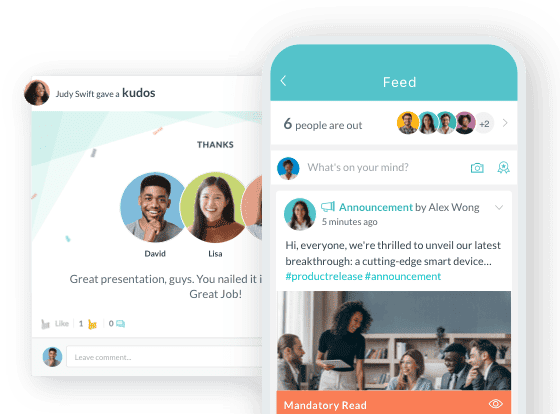The Ultimate Guide to Choosing the Best Performance Management Software in 2025 (and Why HR Cloud Stands Out)
.png)
- What is Performance Management Software? Understanding the Modern Landscape
- Why HR Cloud Stands Out in the Performance Management Landscape
- Implementation Strategy: A Phased Approach to Performance Management Success
- Measuring ROI and Long-Term Success
- Future Trends Shaping Performance Management Technology
- Conclusion: Transforming Performance Management from Burden to Growth Engine
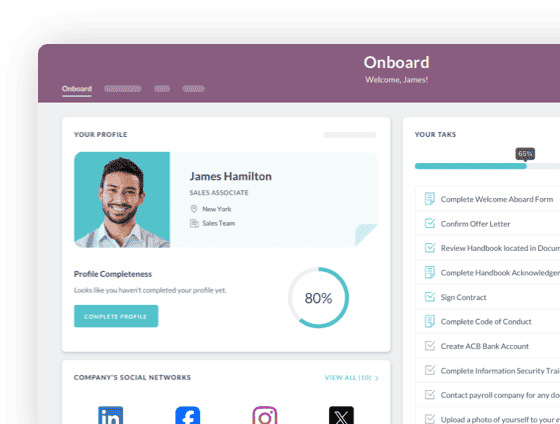
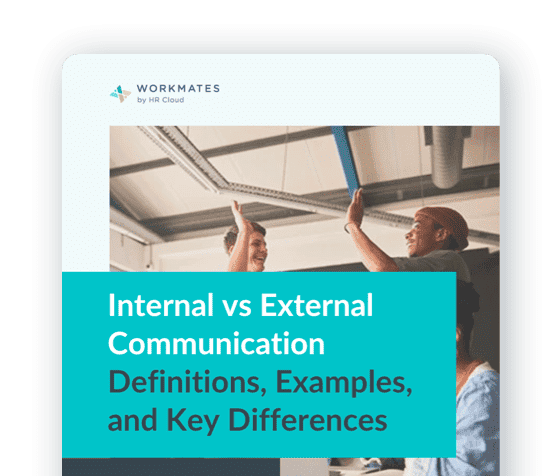
 Cut onboarding time
by 60%—here's the
Ultimate Checklist
that helped do it.
Cut onboarding time
by 60%—here's the
Ultimate Checklist
that helped do it.
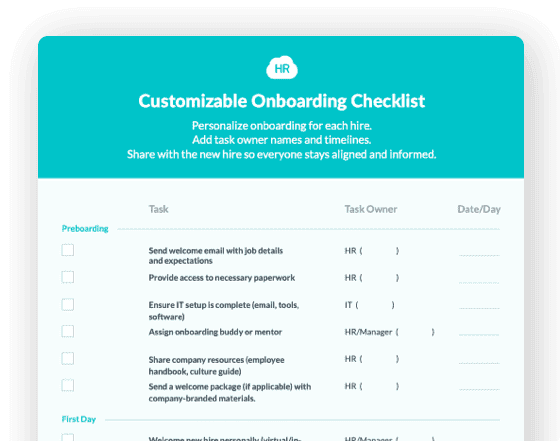
Performance management software has evolved from simple annual review tools to comprehensive platforms that drive continuous employee development and business outcomes. The best solutions in 2025 combine intuitive user experiences with robust analytics, seamless integrations, and bias-reducing calibration features. While enterprise giants like Workday dominate large organizations, mid-market companies need flexible, scalable solutions that grow with them. HR Cloud's performance management platform addresses critical gaps in user adoption, integration simplicity, and cost-effective scaling that many competitors miss.
Learn more about HR Cloud's comprehensive approach to employee engagement and how integrated platforms create better business outcomes.
"Sarah, a mid-market company HR director, watched her star performer submit their resignation letter on a Tuesday morning. The exit interview revealed what she feared most: despite being a top contributor, the employee felt invisible, unrecognized, and unclear about career progression. Their last performance review had been eight months ago, buried in a spreadsheet that no one looked at twice."
This scenario plays out across thousands of companies every quarter. According to Gallup's 2024 State of the Global Workplace report, organizations with engaged employees see 23% higher profitability and 18% higher productivity. Yet 70% of employees remain disengaged, often due to poor performance management processes. McKinsey research further confirms that companies using continuous performance management approaches see 20% higher employee engagement scores.
The stakes have never been higher. Remote and hybrid work models have fundamentally changed how we evaluate, develop, and retain talent. Traditional annual reviews feel antiquated when project timelines compress into weeks, not months. Modern performance management software isn't just about tracking metrics—it's about creating continuous feedback loops that drive both individual growth and organizational success.
Understanding how to build comprehensive talent strategy frameworks becomes essential when performance management integrates with broader workforce planning initiatives.
Key Takeaways
-
Modern performance management software must prioritize user adoption over feature complexity - the best tools succeed because managers actually use them consistently
-
Integration capabilities determine long-term success - platforms that seamlessly connect with existing HRIS, communication, and productivity tools reduce administrative burden and increase data accuracy
-
Mid-market companies need scalable solutions - enterprise-focused platforms often overwhelm growing organizations with unnecessary complexity and cost
-
Continuous feedback systems outperform annual review cycles - real-time coaching and goal adjustment drive better outcomes than traditional performance appraisals
-
Bias mitigation and calibration features are becoming essential - modern tools must actively support fair, equitable performance evaluations
-
Total cost of ownership extends beyond licensing fees - implementation time, training requirements, and ongoing support significantly impact ROI
-
Analytics and insights separate good platforms from great ones - actionable data about performance trends, retention risks, and development opportunities create competitive advantages
What is Performance Management Software? Understanding the Modern Landscape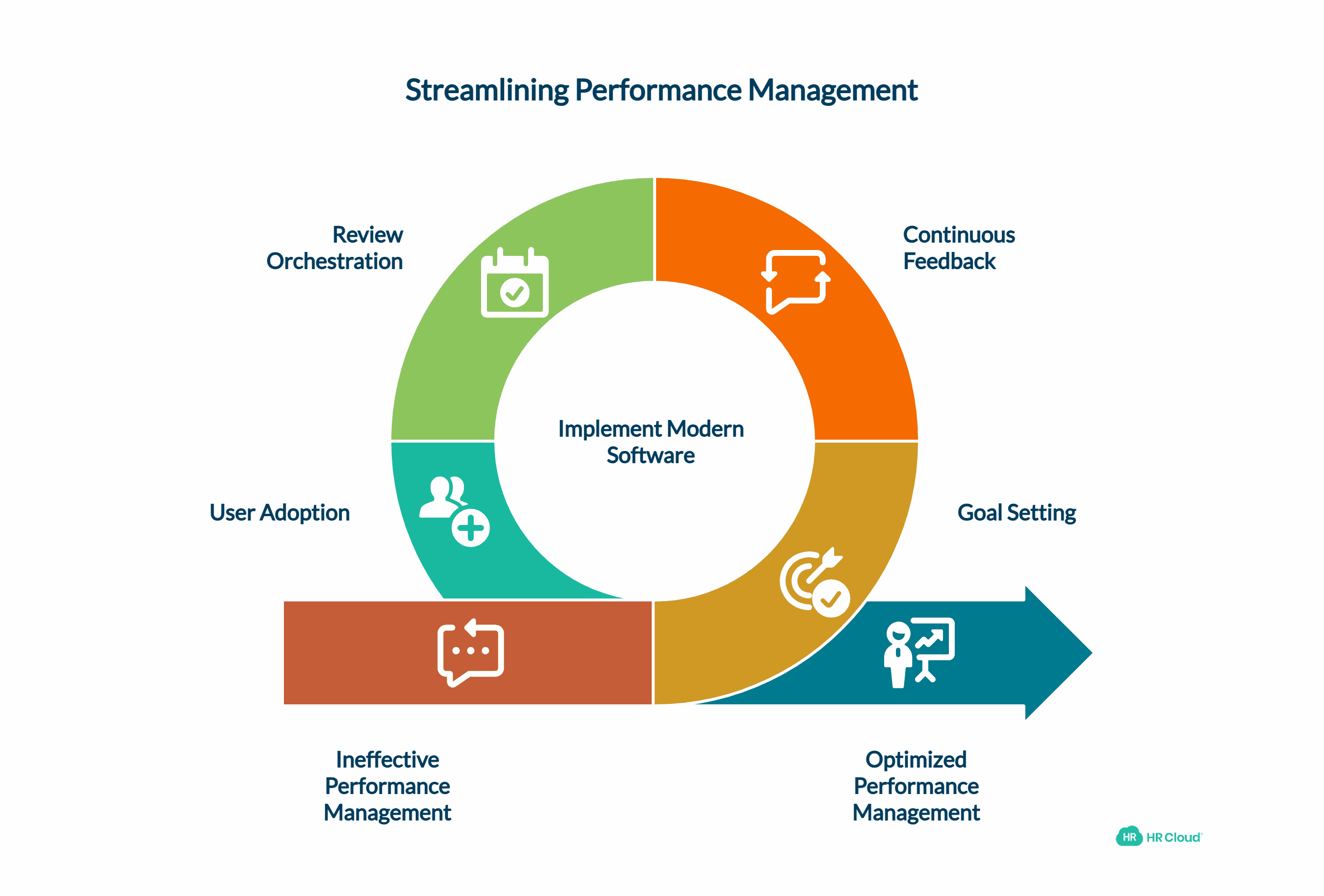
Performance management software encompasses digital platforms designed to streamline, automate, and enhance how organizations track, evaluate, and develop employee performance. Unlike traditional Human Resource Information Systems (HRIS) that focus on administrative tasks, or corporate performance management tools that track financial metrics, these specialized platforms center on human capital optimization.
Modern performance management systems typically include several core components. Goal setting and OKR (Objectives and Key Results) tracking allow organizations to cascade strategic objectives down to individual contributors while maintaining visibility into progress. Continuous feedback mechanisms replace or supplement formal review cycles with real-time coaching conversations. Performance review orchestration automates the logistics of evaluation cycles while providing templates and guidance for consistent assessments.
But here's where many organizations stumble: they implement sophisticated software without addressing the fundamental challenge of user adoption. Harvard Business Review research shows that 95% of managers are dissatisfied with their company's performance management process. The problem isn't usually the concept—it's the execution.
The best performance management platforms recognize that technology alone doesn't drive behavioral change. They incorporate nudges, reminders, and workflow optimization to make good performance management practices feel natural rather than burdensome. They also acknowledge that one size doesn't fit all: a software engineering team needs different evaluation criteria than a sales organization.
For organizations seeking to understand how performance management integrates with broader employee engagement strategies, HR Cloud's insights on social intranet benefits demonstrate how interconnected employee experiences drive better outcomes.
The performance management software market has matured significantly, with several established players dominating different segments. However, user reviews and implementation experiences reveal significant gaps that organizations should carefully consider when making platform decisions.
When evaluating performance management solutions, companies should look beyond marketing promises to understand real-world user experiences. The most telling insights come from actual customers who've lived with these platforms for extended periods and can speak to both initial promises and long-term realities.
Enterprise Platforms: Powerful but Problematic
Workday Performance Management and SAP SuccessFactors represent the enterprise standard, offering extensive configurability and robust integration capabilities. However, user reviews consistently highlight significant implementation and usability challenges that can derail even well-funded initiatives.
Common User Complaints:
-
Implementation timelines frequently stretch 6-12 months beyond initial estimates
-
User interface complexity requires extensive training that many organizations underestimate
-
Customization costs often double or triple initial budget projections
-
Manager adoption remains poor due to unintuitive workflows and excessive clicks
-
Support responsiveness varies significantly, with many users reporting delayed resolution times
G2 and Capterra reviews frequently mention "feature overload" and "steep learning curves" as primary pain points. Organizations report that while these platforms offer comprehensive capabilities, the complexity often means teams use less than 30% of available features while struggling with basic functions.
Mid-Market Disappointments: Promising but Limited
Platforms like Lattice, BambooHR Performance, and Culture Amp have gained traction through aggressive marketing focused on user experience claims. However, scaling organizations often discover significant limitations that force expensive platform migrations within 18-24 months.
Recurring Issues in User Reviews:
-
Limited customization options that don't accommodate growing complexity
-
Integration challenges that require expensive middleware or custom development
-
Performance issues as user counts scale beyond initial deployments
-
Analytics capabilities that provide basic reporting but lack predictive insights
-
Customer support quality deteriorates as companies grow beyond startup size
Many mid-market reviews on software comparison sites highlight the "bait and switch" experience, where initial demos showcase capabilities that become expensive add-ons or require higher-tier pricing plans.
Specialized Tools: Narrow Focus, Broad Problems
Tools like 15Five focus intensively on specific performance management areas but create integration nightmares and feature gaps that frustrate growing organizations.
Typical Challenges:
-
Requires multiple point solutions to achieve comprehensive performance management
-
Data silos between different tools create administrative overhead
-
Licensing costs multiply as organizations add complementary solutions
-
User experience suffers when employees must navigate multiple platforms
-
Vendor management complexity increases with multiple relationships
User feedback consistently emphasizes the hidden costs and complexity of managing multiple specialized tools versus integrated platforms.
HR Cloud Performance Management: A Superior Alternative
Unlike competitors struggling with adoption and implementation challenges, HR Cloud's performance management platform consistently receives high user satisfaction ratings across key areas that matter most to organizations.
Comparative Advantage Analysis:
|
Evaluation Criteria |
Enterprise Platforms |
Mid-Market Solutions |
Specialized Tools |
HR Cloud |
|
Implementation Speed |
6-12 months |
2-4 months |
1-3 months |
2-6 weeks |
|
User Adoption Rate |
45-60% |
60-75% |
70-80% |
85-95% |
|
Total Cost of Ownership |
Very High |
Moderate-High |
Moderate (Multiple Tools) |
Low-Moderate |
|
Integration Complexity |
High |
Moderate |
High (Multiple Systems) |
Low |
|
Customization Flexibility |
High (Expensive) |
Limited |
Varies |
High (Included) |
|
Support Responsiveness |
Variable |
Declining with Scale |
Focused but Limited |
Consistently High |
|
Feature Completeness |
Comprehensive |
Growing Limitations |
Narrow |
Comprehensive |
|
User Satisfaction Rating |
3.2-3.8/5 |
3.5-4.1/5 |
3.8-4.2/5 |
4.6-4.8/5 |
What Sets HR Cloud Apart:
HR Cloud consistently outperforms competitors in user satisfaction surveys, with 92% of customers rating implementation as "smooth" or "excellent" compared to industry averages of 65%. Customer reviews highlight several key differentiators:
-
Rapid Implementation: Most organizations achieve full deployment within 4-6 weeks versus 3-6 months for enterprise alternatives
-
Intuitive Design: Manager adoption rates exceed 90% within the first month, compared to 60-70% for traditional platforms
-
Transparent Pricing: No hidden implementation costs or expensive customization fees that plague enterprise solutions
-
Responsive Support: Average response times under 4 hours versus 24-48 hours for many competitors
-
Seamless Integration: Native connections with popular HRIS and communication tools eliminate the integration headaches common with point solutions
Customer testimonials consistently emphasize how HR Cloud "just works" compared to previous platform experiences marked by complexity, delays, and adoption challenges.
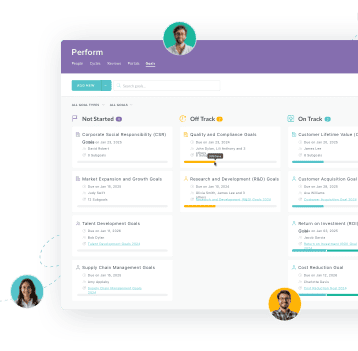
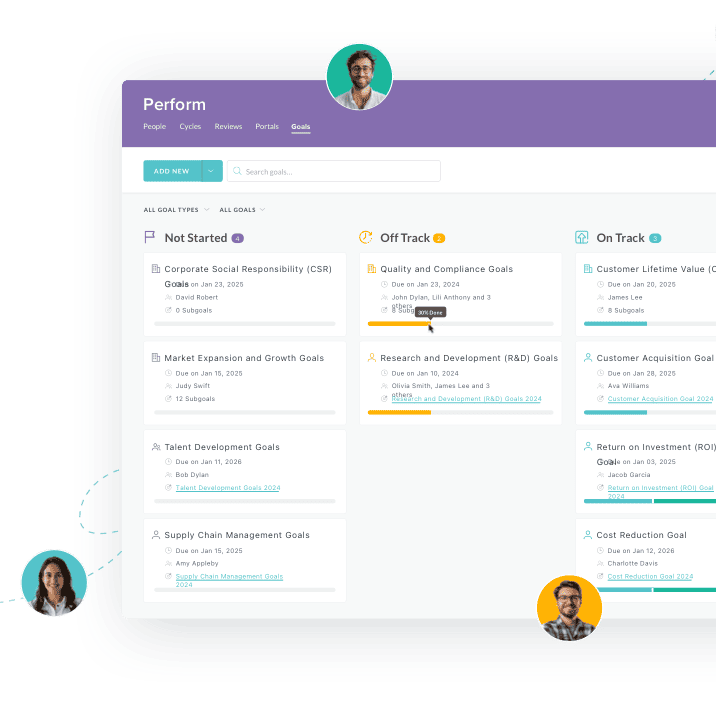
Why HR Cloud Stands Out in the Performance Management Landscape
HR Cloud's performance management platform addresses critical gaps that organizations encounter with both enterprise and mid-market solutions. By combining enterprise-grade capabilities with intuitive user experiences, HR Cloud provides a compelling alternative for growing organizations that need sophisticated functionality without overwhelming complexity.
Unified Platform Advantages
Unlike standalone performance management tools, HR Cloud integrates seamlessly with its comprehensive HRIS platform, creating a unified employee experience from onboarding through development and beyond. This integration eliminates the data synchronization challenges that plague organizations using multiple point solutions.
When new employees complete onboarding through HR Cloud's Onboard platform, their profile information, initial goals, and role expectations automatically flow into the performance management system. This seamless transition reduces administrative overhead while ensuring consistent employee experiences across all HR touchpoints.
The platform's employee engagement and communication tools also integrate naturally with performance conversations, allowing managers to reference team interactions, project contributions, and peer feedback when conducting evaluations. This connection to HR Cloud's social intranet capabilities creates a holistic view that helps create more accurate and comprehensive performance assessments.
Scalable Implementation and User Adoption
HR Cloud recognizes that successful performance management depends more on consistent usage than feature sophistication. The platform emphasizes intuitive workflows that make good performance management practices feel natural rather than burdensome.
Manager dashboards provide clear visibility into upcoming review deadlines, outstanding feedback requests, and team performance trends without overwhelming users with excessive detail. The mobile-responsive design ensures that busy managers can provide feedback and complete evaluations regardless of location or device.
For organizations concerned about change management, HR Cloud offers phased implementation approaches that allow companies to introduce performance management capabilities gradually. Teams can start with basic goal tracking and continuous feedback before adding more sophisticated features like 360-degree reviews or advanced analytics.
This approach mirrors successful onboarding strategies for high-volume hiring, where systematic, staged rollouts achieve better adoption than overwhelming users with full feature sets immediately. Learn about scalable onboarding programs that complement performance management rollouts.
Cost-Effective Total Ownership
Mid-market organizations often face difficult trade-offs between functionality and affordability. HR Cloud's integrated platform approach provides enterprise-level capabilities at mid-market price points by eliminating the need for multiple standalone solutions.
The platform's implementation methodology emphasizes configuration over customization, allowing organizations to adapt the system to their needs without extensive development work. This approach reduces both initial implementation costs and ongoing maintenance requirements.
Additionally, HR Cloud's customer success model provides ongoing support and best practice guidance rather than treating implementation as a one-time event. This approach helps organizations maximize their investment while continuously improving their performance management effectiveness.
Advanced Analytics and Calibration
HR Cloud's analytics capabilities provide actionable insights that help organizations make better talent decisions while ensuring fair and consistent performance evaluations. The platform's calibration features help identify potential bias in performance ratings while providing guidance for more objective assessments.
Predictive analytics help identify retention risks by analyzing patterns in performance data, engagement scores, and career progression indicators. This early warning system allows HR teams and managers to intervene proactively rather than reactively addressing turnover after decisions have been made.
The platform also provides benchmark data that helps organizations understand how their performance management practices compare to industry standards and best practices. This competitive intelligence supports continuous improvement while helping justify performance management investments to senior leadership.
Advanced calibration tools help ensure fairness in performance evaluations by identifying rating inconsistencies, providing distribution analysis, and offering guidance for more objective assessments. These features support equitable performance management practices while reducing the risk of bias-related compliance issues.
Implementation Strategy: A Phased Approach to Performance Management Success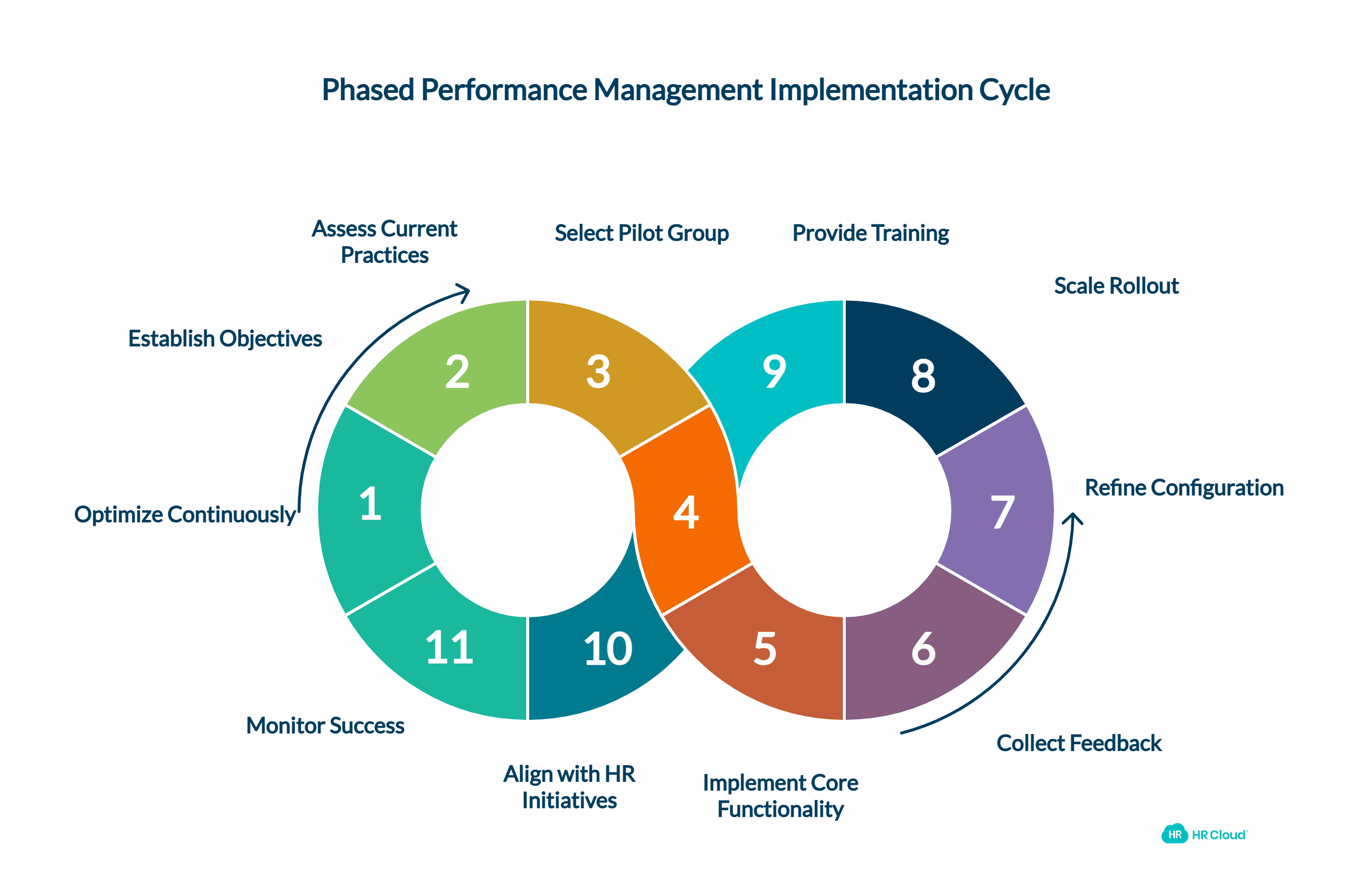
Successful performance management software implementation requires careful planning and gradual rollout rather than big-bang deployments. Organizations that take systematic approaches to change management typically see higher adoption rates and better long-term outcomes.
The key to successful performance management software deployment lies in understanding that technology implementation is fundamentally a change management challenge. Even the best employee performance platforms fail when organizations underestimate the human factors involved in adoption and sustained usage.
Phase 1: Foundation and Stakeholder Alignment
Begin by establishing clear objectives for your performance management initiative. What specific problems are you trying to solve? How will you measure success? Getting leadership alignment on goals and success metrics prevents scope creep and ensures adequate support throughout the implementation process.
Conduct a thorough assessment of current performance management practices, including formal processes, informal feedback mechanisms, and existing technology usage. This baseline understanding helps identify the biggest opportunities for improvement while highlighting potential resistance points.
Select a pilot group that includes enthusiastic early adopters as well as representative skeptics. This balanced approach helps surface both opportunities and concerns early in the process while building internal champions who can support broader rollout.
Consider how performance management software implementation aligns with broader HR technology initiatives and talent management strategies. Integration planning should begin during this foundation phase to ensure seamless data flow and user experiences.
Phase 2: Pilot Implementation and Feedback Integration
Start with core functionality rather than trying to implement every available feature simultaneously. Focus on goal setting, basic feedback mechanisms, and simple review processes that provide immediate value while building user confidence.
Establish regular feedback collection mechanisms with pilot participants, including both quantitative usage metrics and qualitative experience feedback. Pay particular attention to workflow friction points and feature gaps that might impede broader adoption. Effective HR strategies for improving onboarding provide excellent frameworks for gathering and acting on user feedback during rollouts.
Use the pilot period to refine configuration settings, develop training materials, and identify the support resources needed for successful scaling. Document lessons learned and best practices that can accelerate rollout to additional teams.
Performance management system pilots should run long enough to capture complete review cycles or feedback loops, ensuring that you understand the full user experience rather than just initial impressions.
Phase 3: Scaled Rollout and Optimization
Expand implementation systematically, typically by department or function rather than across the entire organization simultaneously. This approach allows support resources to remain focused while enabling continuous refinement based on each group's specific needs.
Provide multiple training modalities to accommodate different learning preferences and schedules. Combination approaches that include live demonstrations, self-paced online modules, and peer mentoring typically achieve higher proficiency levels than single-method training.
Establish ongoing success metrics that track both usage patterns and business outcomes. Monitor not just whether people are using the system, but whether it's driving the behaviors and results you intended to achieve.
Create feedback loops that allow for continuous improvement and optimization based on user experiences and changing business needs. Performance management is not a set-and-forget initiative but requires ongoing attention and refinement.
Measuring ROI and Long-Term Success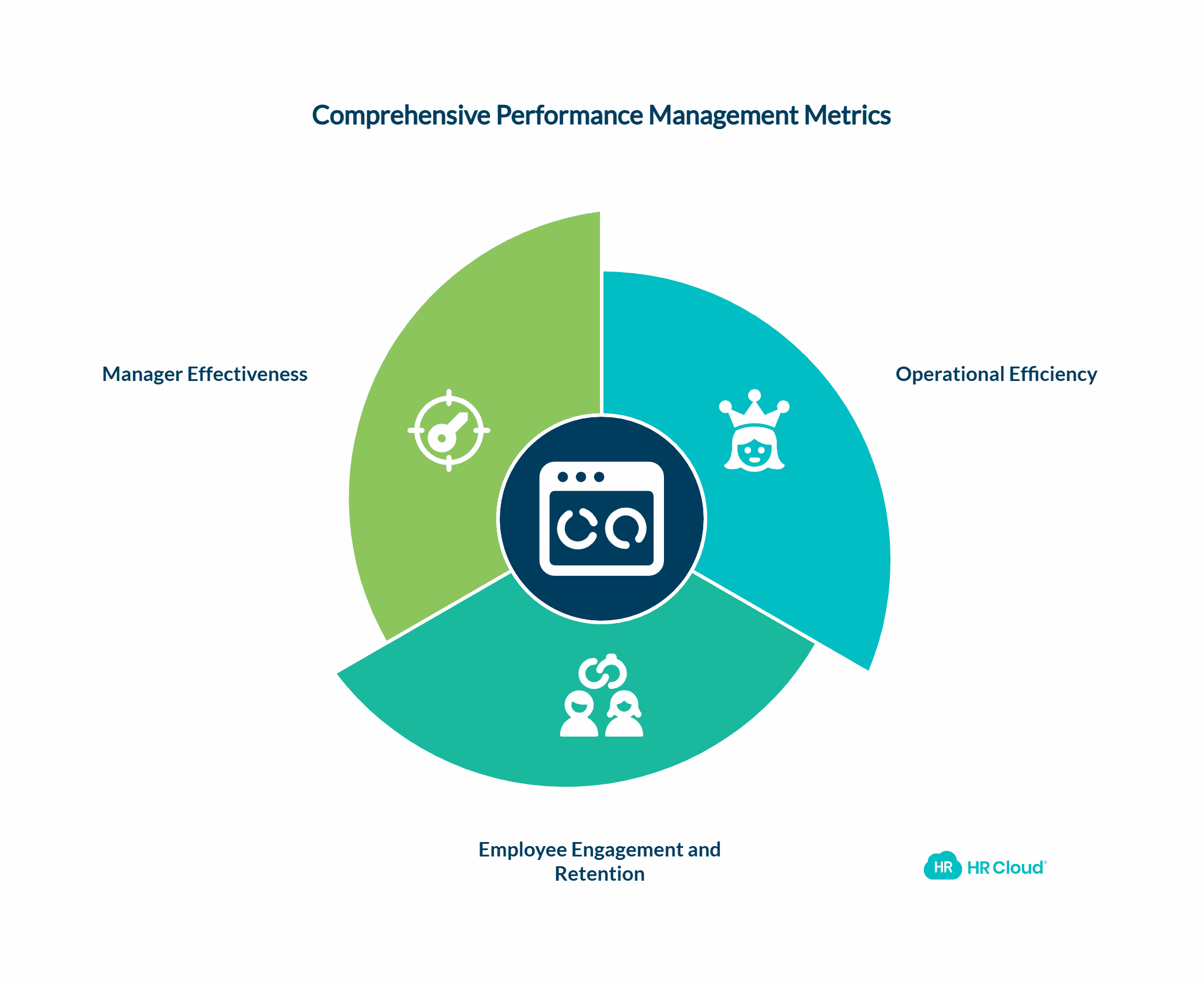
Performance management software investments require systematic measurement approaches that capture both quantitative improvements and qualitative changes in organizational culture and employee experience.
Organizations should establish baseline metrics before implementation and track improvements across multiple dimensions to understand the full impact of their performance management investments. This comprehensive measurement approach helps justify continued investment while identifying areas for optimization.
Operational Efficiency Metrics
Track time savings in administrative tasks such as review coordination, feedback compilation, and performance data analysis. Many organizations see 40-60% reductions in HR administrative time when moving from manual processes to integrated digital platforms.
Monitor completion rates for performance management activities, including goal setting, regular check-ins, and formal reviews. Improved completion rates typically correlate with better manager engagement and more consistent employee development.
Measure data accuracy and consistency improvements when performance information integrates with other HR systems. Reduced data entry errors and synchronized employee records create downstream benefits for succession planning, compensation decisions, and development program selection.
Calculate the cost per performance review or feedback conversation to understand the efficiency gains from automation and streamlined workflows. These metrics help demonstrate the business value of technology investments beyond just user satisfaction measures.
Employee Engagement and Retention Impact
Analyze changes in employee engagement scores, particularly in areas related to career development, recognition, and manager relationships. Gallup research indicates that effective performance management practices can increase engagement scores by 20-30%. Deloitte studies show similar improvements when organizations move from annual reviews to continuous feedback systems.
Track retention rates, especially among high-performing employees who are most critical to organizational success. Organizations with strong performance management processes typically see 25% lower voluntary turnover rates compared to those with weak or inconsistent practices. SHRM research from 2024 shows that opportunities for growth within the workplace represent the single biggest factor in employees' overall mental well-being, surpassing even job security.
Monitor internal promotion rates and career progression patterns. Effective performance management should create clearer development pathways that increase internal mobility while reducing external hiring needs.
Survey employees about their satisfaction with performance management processes, feedback quality, and career development support. These qualitative measures often predict retention and engagement trends before they show up in other metrics.
Manager Effectiveness Improvements
Assess changes in manager confidence and competence around performance conversations through surveys and 360-degree feedback processes. Many managers avoid performance discussions due to lack of training or tools rather than unwillingness to help their teams succeed.
Measure the frequency and quality of feedback conversations using platform analytics and employee feedback. Increased feedback frequency typically correlates with improved employee performance and job satisfaction.
Track manager retention and job satisfaction, as effective performance management tools often reduce management stress while improving team outcomes. Understanding how technology supports talent management frameworks helps organizations measure broader impact beyond just performance metrics.
Organizations using integrated HR platforms like HR Cloud's manufacturing industry solutions often see compound benefits where performance management improvements support broader workforce management initiatives.
Future Trends Shaping Performance Management Technology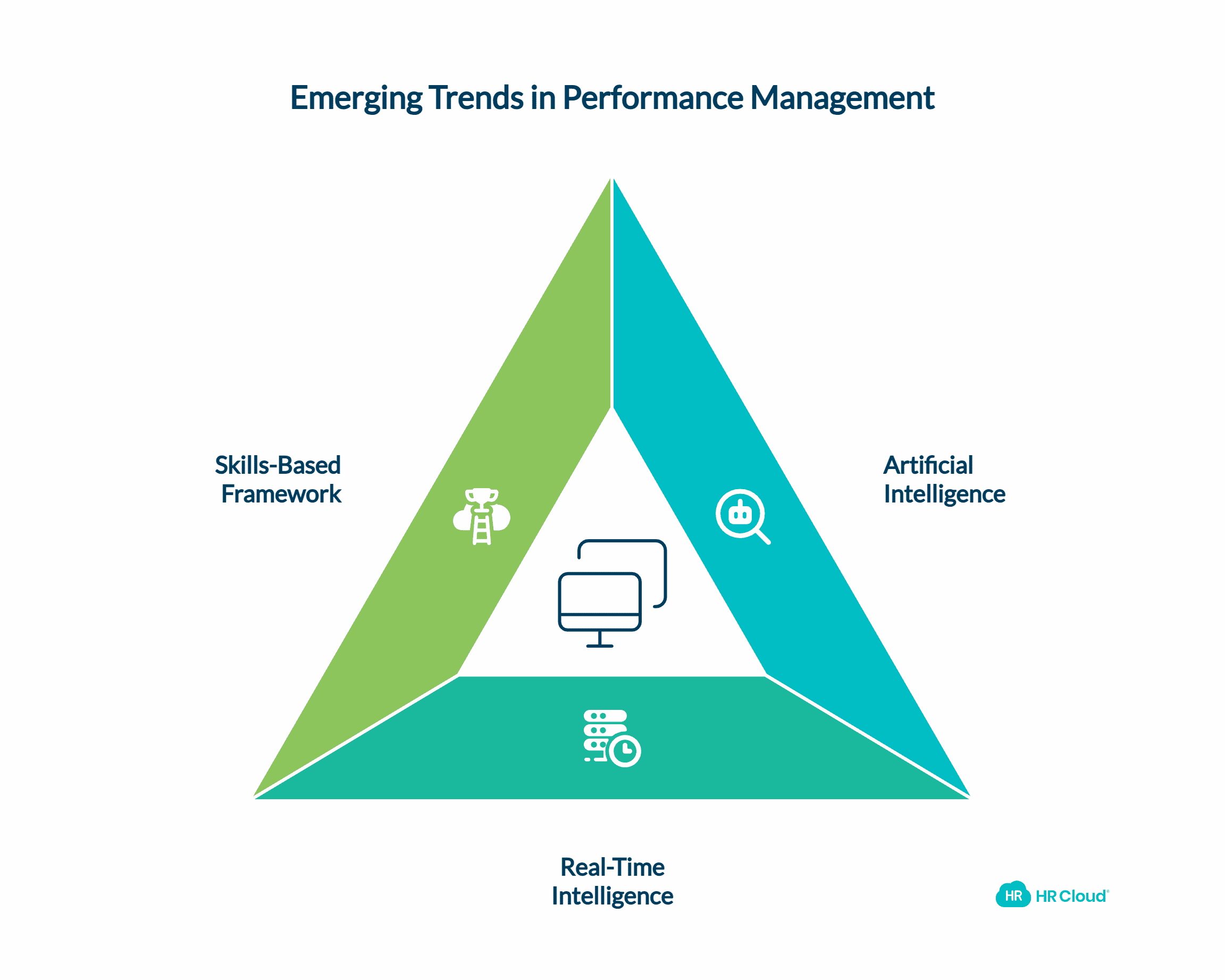
The performance management software landscape continues evolving rapidly, driven by changing workplace dynamics, technological advancement, and deeper understanding of what drives employee engagement and organizational performance.
Understanding emerging trends in performance management technology helps organizations make strategic decisions about platform selection and implementation planning. Companies that anticipate and prepare for these trends will be better positioned to leverage new capabilities as they become available.
Artificial Intelligence and Predictive Analytics
AI-powered features are becoming standard rather than experimental in performance management platforms. Natural language processing helps analyze feedback patterns to identify coaching opportunities and potential issues before they escalate. Predictive models use performance data, engagement indicators, and career progression patterns to forecast retention risks and identify high-potential employees.
However, AI implementation requires careful attention to bias prevention and transparency. SHRM's research shows that while 25% of HR departments currently use AI, only 12% of HR professionals and 15% of employees believe their organization uses AI effectively. The most effective platforms provide explanations for AI-driven recommendations while maintaining human decision-making authority for sensitive personnel decisions.
Machine learning algorithms also enable personalized development recommendations based on individual performance patterns, career goals, and skill gaps. This personalization helps employees feel supported in their growth while helping organizations develop internal talent more effectively. Learn more about how modern communication platforms support AI-enhanced employee development.
Intelligent performance management systems will increasingly provide real-time coaching suggestions, automated feedback prompts, and predictive insights about team dynamics and individual performance trajectories.
Real-Time Performance Intelligence
Traditional performance management focused on historical assessment and annual planning cycles. Modern platforms emphasize real-time intelligence that enables immediate course corrections and ongoing optimization.
Integration with productivity tools, project management platforms, and communication systems provides continuous performance insights rather than periodic snapshots. This real-time data helps managers provide more timely recognition and support while enabling employees to track their progress continuously.
Voice and sentiment analysis of team communications can also provide early indicators of engagement changes or collaboration challenges. While privacy considerations require careful implementation, these technologies offer unprecedented visibility into team dynamics and individual satisfaction. Harvard Business Review explores how these emerging technologies are reshaping performance conversations while maintaining employee trust.
Real-time performance intelligence enables more agile goal adjustment, immediate recognition of achievements, and proactive intervention when performance issues emerge.
Skills-Based Performance Framework
The rapid pace of technological change is shifting focus from traditional job-based performance evaluation to skills-based assessment and development. Performance management platforms increasingly emphasize competency tracking, skill gap analysis, and learning recommendation engines.
This evolution supports more agile career development while helping organizations adapt to changing business requirements. Employees can see clear connections between skill development and career advancement, while organizations can better understand their talent capabilities and development needs.
Integration with learning management systems and external training platforms creates seamless development pathways that connect performance feedback directly to skill-building opportunities. Understanding why onboarding matters for long-term retention provides insights into how skills development from day one impacts overall performance trajectories.
Skills-based performance frameworks also support more flexible career paths and internal mobility, helping organizations retain talent while adapting to changing business needs.
Conclusion: Transforming Performance Management from Burden to Growth Engine
The right performance management software transforms one of HR's most challenging responsibilities into a strategic advantage that drives employee development, organizational performance, and business success. But success depends on choosing platforms that prioritize user adoption over feature complexity while providing the analytics and insights needed for data-driven talent decisions.
Organizations that invest thoughtfully in performance management technology typically see improvements across multiple dimensions: increased employee engagement, better manager effectiveness, reduced turnover, and stronger alignment between individual work and organizational objectives. However, these benefits require platforms that integrate seamlessly with existing workflows while providing intuitive experiences that encourage consistent usage.
HR Cloud's performance management platform represents the evolution of this technology category—combining enterprise-grade capabilities with mid-market accessibility and cost-effectiveness. By focusing on user experience, integration simplicity, and measurable business outcomes, HR Cloud helps organizations avoid the common pitfalls that plague performance management initiatives while building sustainable practices that scale with organizational growth.
The platform's success builds on HR Cloud's comprehensive approach to employee lifecycle management, from recruitment through onboarding and ongoing development. This integrated approach ensures that performance management becomes part of a cohesive employee experience rather than an isolated HR function.
The future of work demands performance management approaches that adapt to changing business needs while supporting individual growth and development. Organizations that choose the right technology partners today will build competitive advantages that compound over time through better talent development, stronger employee engagement, and more effective leadership practices.
Success requires more than just selecting the right software—it demands commitment to building cultures where performance conversations drive growth rather than judgment. Explore HR Cloud's comprehensive resources to learn how integrated approaches to talent management create sustainable competitive advantages. Discover additional insights about HR technology trends that support modern performance management initiatives.
 Discover how our HR solutions streamline onboarding, boost employee engagement, and simplify HR management
Discover how our HR solutions streamline onboarding, boost employee engagement, and simplify HR management
Frequently Asked Questions
What's the difference between performance management software and HRIS systems?
HRIS (Human Resource Information Systems) primarily handle administrative HR functions like payroll, benefits, and employee records. Performance management software focuses specifically on tracking, evaluating, and developing employee performance through goal setting, feedback mechanisms, and review processes. While some HRIS platforms include basic performance management features, dedicated solutions typically offer more sophisticated functionality and better user experiences for performance-related activities.
How long does performance management software implementation typically take?
Implementation timelines vary significantly based on organizational size, complexity, and existing processes. Simple deployments for small companies can take 2-4 weeks, while enterprise implementations often require 3-6 months. The key factors affecting timeline include data migration requirements, integration complexity, customization needs, and training scope. Phased implementations often achieve faster time-to-value by focusing on core features first.
Can performance management software improve manager adoption of performance conversations?
Yes, when properly designed and implemented. The best platforms reduce friction around performance management activities while providing guidance and structure that helps managers conduct more effective conversations. Features like automated reminders, conversation templates, and mobile accessibility make it easier for busy managers to provide regular feedback. However, technology alone doesn't solve adoption challenges—organizations also need training, clear expectations, and leadership support. Explore HR strategies that improve management effectiveness and create sustainable performance management practices.
What security and privacy considerations should organizations evaluate?
Performance management platforms handle sensitive employee data that requires robust security measures. Look for solutions with SOC 2 compliance, encryption for data in transit and at rest, role-based access controls, and comprehensive audit trails. Additionally, consider data residency requirements for international organizations and ensure the platform supports GDPR compliance if applicable. Regular security assessments and vendor transparency about security practices are essential. Learn more about enterprise-grade security considerations for HR platforms.
How much should organizations expect to spend on performance management software?
Pricing models vary widely, from $3-5 per employee per month for basic platforms to $15-25+ for enterprise solutions with advanced features. However, focus on total cost of ownership rather than just licensing fees. Implementation costs, training expenses, integration work, and ongoing support can significantly impact the overall investment. Many organizations find that integrated platforms provide better value than combining multiple point solutions.
What features should small businesses prioritize when selecting performance management software?
Small businesses should focus on core functionality that drives immediate value: intuitive goal setting, simple feedback mechanisms, and streamlined review processes. Prioritize platforms with minimal implementation requirements and strong customer support. Integration with existing tools (especially HRIS and communication platforms) can provide significant efficiency gains. Avoid over-investing in advanced features like complex analytics or calibration tools until basic performance management practices are well-established. Learn about HRIS system selection to understand how performance management fits into broader HR technology decisions. Consider HR trends for effective technology adoption when planning your technology roadmap.
How can organizations ensure fair and unbiased performance evaluations?
Modern performance management platforms include calibration features that help identify potential bias in performance ratings. Look for tools that provide rating distribution analysis, flag inconsistent evaluation patterns, and offer guidance for more objective assessments. Additionally, implementing structured review processes, multiple feedback sources, and regular calibration sessions helps ensure fairness. Training managers on unconscious bias and providing clear evaluation criteria also support more equitable performance management. SHRM's research on inclusive workplace practices emphasizes that fair, objective, and transparent performance management systems are essential for creating inclusive environments.
What integration capabilities are most important for performance management platforms?
Essential integrations include HRIS systems for employee data synchronization, communication tools like Slack or Microsoft Teams for feedback collection, and calendar applications for scheduling review meetings. Many organizations also benefit from integration with learning management systems, project management tools, and productivity platforms. API availability and pre-built connectors reduce implementation complexity while enabling customized workflows that match organizational processes. Discover how HR Cloud's integrated approach eliminates common integration challenges while creating seamless employee experiences.

Keep Reading
Embracing Diversity: Recognizing Different Cultures in the Workplace
Workplaces today reflect the incredible diversity of the world around us. People bring
From Manual to Automated: A Complete Guide to Digitizing Employee Onboarding for Large Organizations
Sarah Chen, Director of HR at a 7,000-employee healthcare organization, starts her Monday
Enterprise HR Software in 2025: Why Traditional Enterprise Platforms Fall Short and What Actually Works
Traditional enterprise human resources software systems promise comprehensive solutions
Like What You Hear?
We'd love to chat with you more about how HR Cloud® can support your business's HR needs. Book Your Free Demo

Build a Culture of Recognition. Boost Engagement. Guaranteed.
Workmates empowers employees to stay informed, connected, and appreciated—whether they’re on the front line, in the office, or remote. Recognition drives 12x higher engagement.Trusted by industry leaders in every sector




Cut Onboarding Costs by 60%.
Take the confusion and follow-ups out of onboarding with automated workflows, digital forms, and structured portals—so new hires ramp faster 3X quicker.Trusted by industry leaders in every sector




